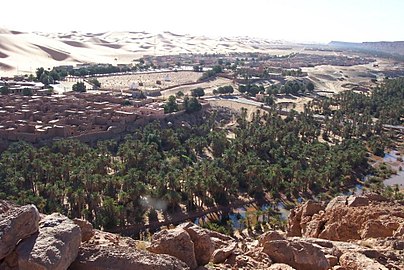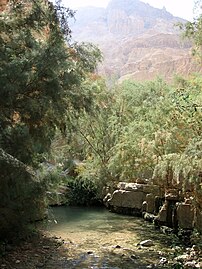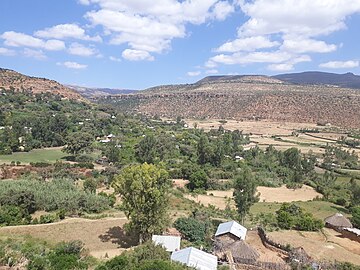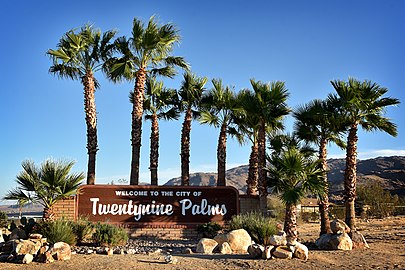Оаза — разлика између измена
. ознака: везе до вишезначних одредница |
|||
| Ред 1: | Ред 1: | ||
{{Short description|Плодно подручје у пустињском окружењу}} |
|||
{{друго значење|река у Француској|[[Оаза (река)]]}} |
{{друго значење|река у Француској|[[Оаза (река)]]}} |
||
{{друго значење|департман у Француској|[[Оаза (департман)]]}} |
{{друго значење|департман у Француској|[[Оаза (департман)]]}} |
||
[[Датотека:Oasis in Lybia.JPG|thumb|250п|Оаза у [[Libya|либијском]] делу [[Sahara|Сахаре]]<ref name=geo>{{cite book|title=Encyclopedia of World Geography, Volume 1|url=https://books.google.com/books?id=DJgnebGbAB8C&dq=libya+geography&pg=PA543|first= R. W. |last=McColl|page=543|publisher=Infobase Publishing|year=2014|isbn=9780816072293}}</ref><ref name=cia>{{cite web|title=Libya profile|url=https://www.cia.gov/the-world-factbook/countries/libya/|year=2016|access-date=23 November 2016}}</ref><ref>{{cite book|title=The Libyan Economy: Economic Diversification and International Repositioning|url=https://books.google.com/books?id=8iw-OlGJsJ8C&dq=libya+geography&pg=PA1|pages=1–3|first= Waniss|last1= Otman|first2= Erling|last2= Karlberg |publisher=Springer Science & Business Media |year=2007|isbn=9783540464631}}</ref>]] |
|||
[[Датотека:Liwa شيا - panoramio.jpg|thumb|250п|Стабла [[Date palm|урме]] у оази [[Liwa Oasis|Лива]]<ref name="OBG2010">{{cite book |publisher=Oxford Business Group |title=The Report Abu Dhabi 2010 |chapter=Al Gharbia |page=171 |chapter-url=https://books.google.com/books?id=f9l90XsF5-sC&pg=PA167 |isbn=978-1-9070-6521-7 |year=2010}}</ref><ref>{{cite web|url=http://lexicorient.com/e.o/liwa_o.htm|title=Liwa Oasis|access-date=2012-07-05|publisher=Lexiorient}}</ref><ref>{{cite book|url=https://books.google.com/books?id=f9l90XsF5-sC&pg=PA167|title=The Report: Abu Dhabi 2010|date=21 March 2019|publisher=Oxford Business Group|isbn=9781907065217|via=Google Books}}</ref>]] |
|||
| ⚫ | |||
| ⚫ | '''Оаза''' ([[Грчки језик|грч.]] ὄασις) је изолована област богате вегетације усред [[Пустиња|пустиње]].<ref name=":1"> [http://hal.archives-ouvertes.fr/halshs-00004609 Battesti, Vincent (2005) Jardins au désert: Évolution des pratiques et savoirs oasiens: Jérid tunisien. Paris: IRD éditions.] {{ISBN|978-2-7177-2584-1}}.</ref> Оазе се типично налазе у околини [[вода|воде]] у [[извор (вода)|изворима]], [[бунар|бунарима]] или се она допрема [[наводњавање]]м. |
||
| ⚫ | |||
| ⚫ | |||
Многе оазе су вештачке. Оне су често једина места у [[пустиња]]ма која подржавају [[усев]]е и стално настањивање. |
Многе оазе су вештачке. Оне су често једина места у [[пустиња]]ма која подржавају [[усев]]е и стално настањивање. Оазе су од кључног значаја за саобраћајне и трговачке путеве у пустињама. Пустињски каравани се снабдевају водом и храном у оазама. Најзначајније светске оазе се налазе у Египту ([[Оаза Сива|Сива]], [[Оаза Бахрија|Бахрија]]), Либији ([[Оаза Куфра|Куфра]]), Алжиру ([[Оаза Уаргла|Уаргла]]), Израелу ([[Еин Геди]]), Саудијској Арабији ([[Ел Катиф]]), Кини ([[Турпан]], [[Јарканд]]), Чилеу ([[Сан Педро де Атакама]]), САД и Мексику. |
||
== Етимологија == |
|||
Оазе су од кључног значаја за саобраћајне и трговачке путеве у пустињама. Пустињски каравани се снабдевају водом и храном у оазама. |
|||
{{рут}} |
|||
The word ''oasis'' came into English from {{lang-la|oasis}}, from {{lang-grc|ὄασις}}, {{lang|grc-Latn|óasis}}, which in turn is a direct borrowing from [[Demotic (Egyptian)|Demotic Egyptian]]. The word for ''oasis'' in the latter-attested [[Coptic language]] (the descendant of Demotic Egyptian) is ''wahe'' or ''ouahe'' which means a "dwelling place".<ref name="OnlineEtymology">{{cite dictionary|url=http://www.etymonline.com/index.php?search=oasis&searchmode=none|title=Etymonline - Origin of 'Oasis'|author=Douglas Harper|dictionary=Online Etymology Dictionary|access-date=2011-07-30}}</ref> |
|||
== Опис == |
|||
Најзначајније светске оазе се налазе у Египту ([[Оаза Сива|Сива]], [[Оаза Бахрија|Бахрија]]), Либији ([[Оаза Куфра|Куфра]]), Алжиру ([[Оаза Уаргла|Уаргла]]), Израелу ([[Еин Геди]]), Саудијској Арабији ([[Ел Катиф]]), Кини ([[Турпан]], [[Јарканд]]), Чилеу ([[Сан Педро де Атакама]]), САД и Мексику. |
|||
Oases are made fertile when sources of freshwater, such as underground rivers or [[aquifer]]s, irrigate the surface naturally or via man-made wells.<ref>{{Cite news|url=https://www.nationalgeographic.org/encyclopedia/oasis/|title=oasis|date=2011-06-10|work=National Geographic Society|access-date=2018-04-30|language=en}}</ref> |
|||
The presence of water on the surface or underground is necessary and the local or regional management of this essential resource is strategic, but not sufficient to create such areas: continuous human work and know-how (a technical and social culture) are essential to maintain such ecosystems.<ref name=":2">[http://hal.archives-ouvertes.fr/hal-00569337 Vincent Battesti, The Power of a Disappearance: Water in the Jerid region of Tunisia ''in'' B. R. Johnston ''et al.'' (eds), ''Water, Cultural Diversity & Global Environmental Change: Emerging Trends, Sustainable Futures?'', 2012, UNESCO/Springer, {{p.|77-96}}]. {{ISBN|978-9400717732}}.</ref><ref name=":4">[https://hal.archives-ouvertes.fr/hal-01154717 Vincent Battesti, Resources and Appropriations: Back to the Jerid Oases (Tunisia) after the Revolution, ''Études rurales'' 2015, vol. 2013/2 (192): 153-175] {{ISSN|0014-2182}} {{ISBN|978-2-7132-2398-3}}</ref> |
|||
Rain showers provide subterranean water to sustain natural oases, such as the [[Tuat]]. Substrata of impermeable rock and stone can trap water and retain it in pockets, or on long faulting subsurface ridges or volcanic dikes water can collect and percolate to the surface. Any incidence of water is then used by [[migrating bird]]s, which also pass seeds with their droppings which will grow at the water's edge forming an oasis. It can also be used to plant crops. |
|||
== Историјски значај == |
|||
The location of oases has been of critical importance for trade and transportation routes in desert areas; caravans must travel via oases so that supplies of water and food can be replenished. Thus, political or military control of an oasis has in many cases meant control of trade on a particular route. For example, the oases of [[Awjila]], [[Ghadames]] and [[Kufra]], situated in modern-day [[Libya]], have at various times been vital to both north–south and east–west [[Trans-Saharan trade|trade in the Sahara Desert]]. The [[Silk Road]] across Central Asia also incorporated several oases. |
|||
In [[North American]] history, oases have been less prominent because the desert regions are smaller; however, several areas in the deep [[southwestern United States]] have oases regions that served as important links through the hot deserts and vast rural areas. While present-day desert cities like [[Las Vegas]], [[Phoenix, Arizona|Phoenix]], [[Palm Springs]], and [[Tucson]] are large modern cities, many of these locations were once small, isolated farming areas at which travelers through the western desert stopped for food and supplies. Even today, there are several roads that go through western deserts like [[U.S. Route 50]] through southern [[Nevada]], and the [[Mojave Desert]] that feature small green fields, citrus groves and small isolated supply towns. |
|||
== Узгој биљака == |
|||
People who live in an oasis must manage land and water use carefully; fields must be irrigated to grow [[plant]]s like [[apricot]]s, [[Date palm|dates]], [[Common fig|figs]], and [[olive]]s. The most important plant in an oasis is the date palm, which forms the upper layer. These palm trees provide shade for smaller trees like [[peach]] trees, which form the middle layer. By growing plants in different layers, the farmers make best use of the soil and water. Many vegetables are also grown and some cereals, such as [[barley]], [[millet]], and [[wheat]], are grown where there is more moisture.<ref name=":0">{{Cite news|url=https://www.britannica.com/science/oasis-geological-feature|title=Oasis {{!}} geological feature|work=Encyclopedia Britannica|access-date=2018-04-30|language=en}}</ref> |
|||
In summary, an oasis palm grove is a highly anthropized and irrigated area that supports a traditionally intensive and polyculture-based agriculture.<ref name=":1" /> The oasis is integrated into its desert environment through an often close association with nomadic [[transhumant]] livestock farming (very often pastoral and sedentary populations are clearly distinguished). However, the oasis is emancipated from the desert by a very particular social and [[ecosystem]] structure. Responding to environmental constraints, it is an integrated agriculture that is conducted with the superposition (in its typical form) of two or three strata creating what is called the "oasis effect":<ref name=":1" /> |
|||
* the first and highest stratum is made up of date palms ([[date palm|''Phoenix dactylifera'' L.]]) and maintains freshness; |
|||
* an intermediate stratum includes fruit trees (orange, banana, pomegranate, apple, etc.); |
|||
* the third stratum, in the shade, of herbaceous plants (market gardening, fodder, cereals). |
|||
== Галерија == |
|||
<gallery widths="250px" heights="180px" mode="packed"> |
|||
File:Jabal Al Qara Cave - Al Hassa, Saudi Arabia ജബൽ അൽ ഖാറ ഗുഹ, അൽ ഹസ, സൗദി അറേബ്യ 13.JPG|[[Al-Ahsa Oasis]], also known as Al-Hasa Oasis, in [[Saudi Arabia]] is the largest oasis in the world<ref>{{Cite web |date=2017-05-12 |title=نبذة عن الأحساء {{!}} صحيفة الأحساء نيوز |url=https://web.archive.org/web/20170512193944/http://www.hasanews.com/%D9%86%D8%A8%D8%B0%D8%A9-%D8%B9%D9%86-%D8%A7%D9%84%D8%A3%D8%AD%D8%B3%D8%A7%D8%A1 |access-date=2022-04-21 |website=web.archive.org}}</ref><ref name="unesco">{{cite web|url=https://whc.unesco.org/en/list/1563/multiple=1&unique_number=2228|title=Al-Ahsa Oasis, an evolving Cultural Landscape|work=UNESCO}}</ref> |
|||
File:Al Ain Oasis, Al Mutawaa - Abu Dhabi - United Arab Emirates - panoramio.jpg|[[Al Ain Oasis]]<ref name="VAD">{{citation |work=VisitAbuDhabi.ae |script-title=ar:واحة العين |language=ar |url=https://visitabudhabi.ae/ar/see.and.do/attractions.and.landmarks/family.attractions/al.ain.oasis.aspx |access-date=2018-03-28}}</ref><ref name="Al-Khaleej 2014">{{cite news |work=[[Al Khaleej (newspaper)|Al-Khaleej]] |script-title=ar:واحة العين مجمع التاريخ وملتقى الجمال |language=ar |url=http://www.alkhaleej.ae/supplements/page/280699ff-130a-4485-808c-aa3ab62ca4b5 |date=2014-09-04 |access-date=2016-10-12}}</ref> in the city of [[Al Ain]] in the [[United Arab Emirates]]<ref name="UAE Interact 2005">{{citation |url=http://www.uaeinteract.com/docs/An_oasis_in_the_heart_of_Al_Ain/18124.htm |title=An oasis in the heart of Al Ain |publisher=UAE Interact |date=2005-10-10 |access-date=2017-02-23 |archive-url=https://web.archive.org/web/20170223154341/http://www.uaeinteract.com/docs/An_oasis_in_the_heart_of_Al_Ain/18124.htm |archive-date=2017-02-23 |url-status=dead }}</ref> |
|||
File:AG 006 large.jpg|[[Taghit]] in [[Algeria]], North [[Africa]] |
|||
File:ArugotRiver.jpg|[[Ein Gedi]] in [[Israel]], [[Middle East]] |
|||
File:Fish Springs Utah.jpg|[[Fish Springs National Wildlife Refuge]] in [[Utah]], [[United States]] |
|||
File:Rubaksa gardens.jpg|[[Rubaksa]] in a dry limestone environment in north Ethiopia is an oasis thanks to the existence of karstic springs |
|||
File:29 Palms Sign.jpg|[[Twentynine Palms]] sign |
|||
File:Red Rock Canyon National Conservation Area view 031513.JPG|Creosote (''[[Larrea tridentata]]'') on [[alluvium]] at [[Red Rock Canyon National Conservation Area]], southern [[Nevada]]. [[United States]] |
|||
File:Crescent_Moon_Lake_(23889572731).jpg|[[Crescent Lake (Dunhuang)|Crescent Lake]] (Yueyaquan) in the [[Gobi Desert]] |
|||
File:Desert - panoramio (6).jpg|[[Liwa Oasis]] in [[Rub' al Khali]] desert |
|||
File:Huacachina1.jpg|[[Huacachina]] in southwestern [[Peru]]<ref>{{Cite web |url=http://www.discoverychannel.com.au/images/huacachina-oasis-peru/ |title=Discovery Channel Australia: Huacachina |access-date=2016-03-04 |archive-url=https://web.archive.org/web/20161023193326/http://www.discoverychannel.com.au/images/huacachina-oasis-peru/ |archive-date=2016-10-23 |url-status=dead }}</ref>{{Cite web|url=https://issuu.com/fundacionalejandrolabaka/docs/dic_espa__ol_kiwchua_final_20.5/38|title=Diccionario cultural kichwa del Napo|website=Issuu|language=en|access-date=2019-07-24}}</ref><ref>{{Cite web|url=http://dspace.ucuenca.edu.ec/bitstream/123456789/25666/2/6%20Desviaciones%20de%20la%20norma%20est%C3%A1ndar%20en%20el%20habla%20kichwa%20de%20las%20comunidades%20del%20Cant%C3%B3n%20Tena.pdf|title=Desviaciones De La Norma Estándar En El Habla Kichwa |last=Andi Aguinda|first=Bartolo Bolívar}}</ref> |
|||
</gallery> |
|||
== Референце == |
|||
{{reflist| }} |
|||
== Литература == |
|||
{{refbegin|30em}} |
|||
* {{cite book |last1=Battesti |first1=Vincent |title=Jardins au désert, Évolution des pratiques et savoirs oasiens, Jérid tunisien |date=2005 |publisher=IRD Éditions |location=Paris |isbn=9782709915649 |pages=440 |url=http://hal.archives-ouvertes.fr/halshs-00004609}} |
|||
* {{Cite web|url=http://earth-info.nga.mil/gns/html/namefiles.htm |title=Complete Files of Geographic Names for Geopolitical Areas from GNS (ISO/IEC 10646 [Unicode UTF-8] |publisher=Earth-info.nga.mil |access-date=2012-07-05 |url-status=dead |archive-url=https://web.archive.org/web/20120709181017/http://earth-info.nga.mil/gns/html/namefiles.htm |archive-date=2012-07-09 }} |
|||
* {{cite web |url=https://visitabudhabi.ae/en/see.and.do/leisure/events/liwa.international.festival.moreeb.dune.aspx |title=Liwa International Festival / Moreeb Dune |access-date=2019-06-19 |publisher=Abu Dhabi Tourism Office |location=Abu Dhabi }} |
|||
* {{cite journal|last=Motohiro|first=Ono|title=Reconsideration of the Meanings of the Tribal Ties in the United Arab Emirates: Abu Dhabi Emirate in Early ʼ90s|journal=Kyoto Bulletin of Islamic Area Studies|date=March 2011|volume=4-1|issue=2|pages=25–34|url=http://www.asafas.kyoto-u.ac.jp/kias/kyodo/pdf/kb4_1and2/05ono.pdf|access-date=17 April 2013}} |
|||
* {{Cite web |title=Largest cities in Saudi Arabia |url=https://population.mongabay.com/saudi-arabia/ |access-date=2022-04-21 |website=Mongabay}} |
|||
* {{cite web|url=https://www.guinnessworldrecords.com/world-records/largest-oasis|title=Largest oasis|website=Guinness World Records}} |
|||
* {{Cite news|url=http://www.arabnews.com/saudi-arabia/news/849681|title=Al-Ahsa enters UNESCO Creative Cities Network|date=13 December 2015|work=Arab News|access-date=3 October 2018|language=en}} |
|||
* {{cite book|author=Marshall Cavendish|author-link=Marshall Cavendish|title=World and Its Peoples|volume=1|chapter=Geography and climate |publisher=Cavendish Square Publishing |isbn=978-0-7614-7571-2|pages=8–19|url=https://books.google.com/books?id=j894miuOqc4C&q=the+most+important+oases+al-hasa+al+ayn |year=2007}} |
|||
* {{cite web |work=VisitAbuDhabi.ae |title=Al Ain National Museum |url=https://visitabudhabi.ae/en/see.and.do/attractions.and.landmarks/cultural.attractions/al.ain.national.museum.aspx |access-date=2017-08-06}} |
|||
* {{cite book |work=[[Insight Guides]] |title=Insight Guides Oman & the UAE (Travel Guide eBook) |publisher=APA Publications (UK) Limited |url=https://books.google.com/books?id=MAYBCwAAQBAJ&q=al+ain+birthplace+of+sheikh+zayed |date=2015-12-01|isbn=9781780055480 }} |
|||
* {{citation |last1=Yildirim |first1=Ege |last2=El-Masri |first2=Sami |title=Master Planning for Heritage Conservation in Al Ain Oasis, UAE |publisher=[[Abu Dhabi Authority for Culture & Heritage|ADACH]] and [[ISOCARP]] |pages=1–11 |location=[[United Arab Emirates|UAE]] |url=http://www.isocarp.net/Data/case_studies/1705.pdf |year=2010 |access-date=2019-08-15}} |
|||
* {{cite book |author=Wilson, A. |author-link=Andrew Wilson (classical archaeologist) |chapter=Hydraulic Engineering and Water Supply |editor=John Peter Oleson |editor-link=John Peter Oleson |title=Handbook of Engineering and Technology in the Classical World |location=New York |publisher=[[Oxford University Press]] |pages=290–293 |year=2008 |isbn=978-0-19-973485-6 |url=http://glirby.people.wm.edu/COLL100/Oxford-HydraulicEngineering.pdf |access-date=November 1, 2017 |archive-url=https://web.archive.org/web/20171107055629/http://glirby.people.wm.edu/COLL100/Oxford-HydraulicEngineering.pdf |archive-date=2017-11-07 |url-status=dead }} |
|||
* {{cite book |author=Goldsmith, Edward |title=The qanats of Iran |url=http://www.edwardgoldsmith.org/1031/the-qanats-of-iran/ |archive-url=https://web.archive.org/web/20120114034225/http://www.edwardgoldsmith.org/1031/the-qanats-of-iran/ |url-status=dead |archive-date=2012-01-14}} |
|||
{{refend}} |
|||
==Спољашње везе== |
==Спољашње везе== |
||
| Ред 25: | Ред 83: | ||
* [https://web.archive.org/web/20070930061814/http://www.ssg-itzehoe.de/becker/oasen/oasen-dateien/index.htm Свет оаза] |
* [https://web.archive.org/web/20070930061814/http://www.ssg-itzehoe.de/becker/oasen/oasen-dateien/index.htm Свет оаза] |
||
* [https://web.archive.org/web/20070611114117/http://www.geowiss.uni-hamburg.de/i-geogr/data/Libyen_Reader_fertig.pdf Рад универзитета у Хамбургу о оазама и сродним темама] |
* [https://web.archive.org/web/20070611114117/http://www.geowiss.uni-hamburg.de/i-geogr/data/Libyen_Reader_fertig.pdf Рад универзитета у Хамбургу о оазама и сродним темама] |
||
* {{cite news |work=Past Horizons |title=Museum and archaeological park for Abu Dhabi |url=http://www.pasthorizonspr.com/index.php/archives/02/2012/museum-and-archaeological-park-for-abu-dhabi |url-status=dead |archive-url=https://web.archive.org/web/20120306220830/http://www.pasthorizonspr.com/index.php/archives/02/2012/museum-and-archaeological-park-for-abu-dhabi |archive-date=2012-03-06 |access-date=2013-12-21}} |
|||
{{клица-геог}} |
{{клица-геог}} |
||
Верзија на датум 8. јул 2022. у 23:27



Оаза (грч. ὄασις) је изолована област богате вегетације усред пустиње.[7] Оазе се типично налазе у околини воде у изворима, бунарима или се она допрема наводњавањем.
Многе оазе су вештачке. Оне су често једина места у пустињама која подржавају усеве и стално настањивање. Оазе су од кључног значаја за саобраћајне и трговачке путеве у пустињама. Пустињски каравани се снабдевају водом и храном у оазама. Најзначајније светске оазе се налазе у Египту (Сива, Бахрија), Либији (Куфра), Алжиру (Уаргла), Израелу (Еин Геди), Саудијској Арабији (Ел Катиф), Кини (Турпан, Јарканд), Чилеу (Сан Педро де Атакама), САД и Мексику.
Етимологија
Један корисник управо ради на овом чланку. Молимо остале кориснике да му допусте да заврши са радом. Ако имате коментаре и питања у вези са чланком, користите страницу за разговор.
Хвала на стрпљењу. Када радови буду завршени, овај шаблон ће бити уклоњен. Напомене
|
The word oasis came into English from лат. oasis, from стгрч. ὄασις, óasis, which in turn is a direct borrowing from Demotic Egyptian. The word for oasis in the latter-attested Coptic language (the descendant of Demotic Egyptian) is wahe or ouahe which means a "dwelling place".[8]
Опис
Oases are made fertile when sources of freshwater, such as underground rivers or aquifers, irrigate the surface naturally or via man-made wells.[9] The presence of water on the surface or underground is necessary and the local or regional management of this essential resource is strategic, but not sufficient to create such areas: continuous human work and know-how (a technical and social culture) are essential to maintain such ecosystems.[10][11]
Rain showers provide subterranean water to sustain natural oases, such as the Tuat. Substrata of impermeable rock and stone can trap water and retain it in pockets, or on long faulting subsurface ridges or volcanic dikes water can collect and percolate to the surface. Any incidence of water is then used by migrating birds, which also pass seeds with their droppings which will grow at the water's edge forming an oasis. It can also be used to plant crops.
Историјски значај
The location of oases has been of critical importance for trade and transportation routes in desert areas; caravans must travel via oases so that supplies of water and food can be replenished. Thus, political or military control of an oasis has in many cases meant control of trade on a particular route. For example, the oases of Awjila, Ghadames and Kufra, situated in modern-day Libya, have at various times been vital to both north–south and east–west trade in the Sahara Desert. The Silk Road across Central Asia also incorporated several oases.
In North American history, oases have been less prominent because the desert regions are smaller; however, several areas in the deep southwestern United States have oases regions that served as important links through the hot deserts and vast rural areas. While present-day desert cities like Las Vegas, Phoenix, Palm Springs, and Tucson are large modern cities, many of these locations were once small, isolated farming areas at which travelers through the western desert stopped for food and supplies. Even today, there are several roads that go through western deserts like U.S. Route 50 through southern Nevada, and the Mojave Desert that feature small green fields, citrus groves and small isolated supply towns.
Узгој биљака
People who live in an oasis must manage land and water use carefully; fields must be irrigated to grow plants like apricots, dates, figs, and olives. The most important plant in an oasis is the date palm, which forms the upper layer. These palm trees provide shade for smaller trees like peach trees, which form the middle layer. By growing plants in different layers, the farmers make best use of the soil and water. Many vegetables are also grown and some cereals, such as barley, millet, and wheat, are grown where there is more moisture.[12]
In summary, an oasis palm grove is a highly anthropized and irrigated area that supports a traditionally intensive and polyculture-based agriculture.[7] The oasis is integrated into its desert environment through an often close association with nomadic transhumant livestock farming (very often pastoral and sedentary populations are clearly distinguished). However, the oasis is emancipated from the desert by a very particular social and ecosystem structure. Responding to environmental constraints, it is an integrated agriculture that is conducted with the superposition (in its typical form) of two or three strata creating what is called the "oasis effect":[7]
- the first and highest stratum is made up of date palms (Phoenix dactylifera L.) and maintains freshness;
- an intermediate stratum includes fruit trees (orange, banana, pomegranate, apple, etc.);
- the third stratum, in the shade, of herbaceous plants (market gardening, fodder, cereals).
Галерија
-
Al-Ahsa Oasis, also known as Al-Hasa Oasis, in Saudi Arabia is the largest oasis in the world[13][14]
-
Rubaksa in a dry limestone environment in north Ethiopia is an oasis thanks to the existence of karstic springs
-
Twentynine Palms sign
-
Creosote (Larrea tridentata) on alluvium at Red Rock Canyon National Conservation Area, southern Nevada. United States
-
Crescent Lake (Yueyaquan) in the Gobi Desert
-
Liwa Oasis in Rub' al Khali desert
-
Huacachina in southwestern Peru[18]„Diccionario cultural kichwa del Napo”. Issuu (на језику: енглески). Приступљено 2019-07-24.</ref>[19]
Референце
- ^ McColl, R. W. (2014). Encyclopedia of World Geography, Volume 1. Infobase Publishing. стр. 543. ISBN 9780816072293.
- ^ „Libya profile”. 2016. Приступљено 23. 11. 2016.
- ^ Otman, Waniss; Karlberg, Erling (2007). The Libyan Economy: Economic Diversification and International Repositioning. Springer Science & Business Media. стр. 1—3. ISBN 9783540464631.
- ^ „Al Gharbia”. The Report Abu Dhabi 2010. Oxford Business Group. 2010. стр. 171. ISBN 978-1-9070-6521-7.
- ^ „Liwa Oasis”. Lexiorient. Приступљено 2012-07-05.
- ^ The Report: Abu Dhabi 2010. Oxford Business Group. 21. 3. 2019. ISBN 9781907065217 — преко Google Books.
- ^ а б в Battesti, Vincent (2005) Jardins au désert: Évolution des pratiques et savoirs oasiens: Jérid tunisien. Paris: IRD éditions. ISBN 978-2-7177-2584-1.
- ^ Douglas Harper. „Etymonline - Origin of 'Oasis'”. Online Etymology Dictionary. Приступљено 2011-07-30.
- ^ „oasis”. National Geographic Society (на језику: енглески). 2011-06-10. Приступљено 2018-04-30.
- ^ Vincent Battesti, The Power of a Disappearance: Water in the Jerid region of Tunisia in B. R. Johnston et al. (eds), Water, Cultural Diversity & Global Environmental Change: Emerging Trends, Sustainable Futures?, 2012, UNESCO/Springer, p. 77-96. ISBN 978-9400717732.
- ^ Vincent Battesti, Resources and Appropriations: Back to the Jerid Oases (Tunisia) after the Revolution, Études rurales 2015, vol. 2013/2 (192): 153-175 ISSN 0014-2182 ISBN 978-2-7132-2398-3
- ^ „Oasis | geological feature”. Encyclopedia Britannica (на језику: енглески). Приступљено 2018-04-30.
- ^ „نبذة عن الأحساء | صحيفة الأحساء نيوز”. web.archive.org. 2017-05-12. Приступљено 2022-04-21.
- ^ „Al-Ahsa Oasis, an evolving Cultural Landscape”. UNESCO.
- ^ واحة العين, VisitAbuDhabi.ae (на језику: арапски), Приступљено 2018-03-28
- ^ واحة العين مجمع التاريخ وملتقى الجمال. Al-Khaleej (на језику: арапски). 2014-09-04. Приступљено 2016-10-12.
- ^ An oasis in the heart of Al Ain, UAE Interact, 2005-10-10, Архивирано из оригинала 2017-02-23. г., Приступљено 2017-02-23
- ^ „Discovery Channel Australia: Huacachina”. Архивирано из оригинала 2016-10-23. г. Приступљено 2016-03-04.
- ^ Andi Aguinda, Bartolo Bolívar. „Desviaciones De La Norma Estándar En El Habla Kichwa” (PDF).
Литература
- Battesti, Vincent (2005). Jardins au désert, Évolution des pratiques et savoirs oasiens, Jérid tunisien. Paris: IRD Éditions. стр. 440. ISBN 9782709915649.
- „Complete Files of Geographic Names for Geopolitical Areas from GNS (ISO/IEC 10646 [Unicode UTF-8]”. Earth-info.nga.mil. Архивирано из оригинала 2012-07-09. г. Приступљено 2012-07-05.
- „Liwa International Festival / Moreeb Dune”. Abu Dhabi: Abu Dhabi Tourism Office. Приступљено 2019-06-19.
- Motohiro, Ono (март 2011). „Reconsideration of the Meanings of the Tribal Ties in the United Arab Emirates: Abu Dhabi Emirate in Early ʼ90s” (PDF). Kyoto Bulletin of Islamic Area Studies. 4—1 (2): 25—34. Приступљено 17. 4. 2013.
- „Largest cities in Saudi Arabia”. Mongabay. Приступљено 2022-04-21.
- „Largest oasis”. Guinness World Records.
- „Al-Ahsa enters UNESCO Creative Cities Network”. Arab News (на језику: енглески). 13. 12. 2015. Приступљено 3. 10. 2018.
- Marshall Cavendish (2007). „Geography and climate”. World and Its Peoples. 1. Cavendish Square Publishing. стр. 8—19. ISBN 978-0-7614-7571-2.
- „Al Ain National Museum”. VisitAbuDhabi.ae. Приступљено 2017-08-06.
- Insight Guides Oman & the UAE (Travel Guide eBook). Insight Guides. APA Publications (UK) Limited. 2015-12-01. ISBN 9781780055480.
- Yildirim, Ege; El-Masri, Sami (2010), Master Planning for Heritage Conservation in Al Ain Oasis, UAE (PDF), UAE: ADACH and ISOCARP, стр. 1—11, Приступљено 2019-08-15
- Wilson, A. (2008). „Hydraulic Engineering and Water Supply”. Ур.: John Peter Oleson. Handbook of Engineering and Technology in the Classical World (PDF). New York: Oxford University Press. стр. 290—293. ISBN 978-0-19-973485-6. Архивирано из оригинала (PDF) 2017-11-07. г. Приступљено 1. 11. 2017.
- Goldsmith, Edward. The qanats of Iran. Архивирано из оригинала 2012-01-14. г.
Спољашње везе
- Пустиња и оазе
- Свет оаза
- Рад универзитета у Хамбургу о оазама и сродним темама
- „Museum and archaeological park for Abu Dhabi”. Past Horizons. Архивирано из оригинала 2012-03-06. г. Приступљено 2013-12-21.

![Al-Ahsa Oasis, also known as Al-Hasa Oasis, in Saudi Arabia is the largest oasis in the world[13][14]](http://upload.wikimedia.org/wikipedia/commons/thumb/4/4d/Jabal_Al_Qara_Cave_-_Al_Hassa%2C_Saudi_Arabia_%E0%B4%9C%E0%B4%AC%E0%B5%BD_%E0%B4%85%E0%B5%BD_%E0%B4%96%E0%B4%BE%E0%B4%B1_%E0%B4%97%E0%B5%81%E0%B4%B9%2C_%E0%B4%85%E0%B5%BD_%E0%B4%B9%E0%B4%B8%2C_%E0%B4%B8%E0%B5%97%E0%B4%A6%E0%B4%BF_%E0%B4%85%E0%B4%B1%E0%B5%87%E0%B4%AC%E0%B5%8D%E0%B4%AF_13.JPG/360px-Jabal_Al_Qara_Cave_-_Al_Hassa%2C_Saudi_Arabia_%E0%B4%9C%E0%B4%AC%E0%B5%BD_%E0%B4%85%E0%B5%BD_%E0%B4%96%E0%B4%BE%E0%B4%B1_%E0%B4%97%E0%B5%81%E0%B4%B9%2C_%E0%B4%85%E0%B5%BD_%E0%B4%B9%E0%B4%B8%2C_%E0%B4%B8%E0%B5%97%E0%B4%A6%E0%B4%BF_%E0%B4%85%E0%B4%B1%E0%B5%87%E0%B4%AC%E0%B5%8D%E0%B4%AF_13.JPG)
![Al Ain Oasis[15][16] in the city of Al Ain in the United Arab Emirates[17]](http://upload.wikimedia.org/wikipedia/commons/thumb/f/fa/Al_Ain_Oasis%2C_Al_Mutawaa_-_Abu_Dhabi_-_United_Arab_Emirates_-_panoramio.jpg/434px-Al_Ain_Oasis%2C_Al_Mutawaa_-_Abu_Dhabi_-_United_Arab_Emirates_-_panoramio.jpg)








![Huacachina in southwestern Peru[18]„Diccionario cultural kichwa del Napo”. Issuu (на језику: енглески). Приступљено 2019-07-24. </ref>[19]](http://upload.wikimedia.org/wikipedia/commons/thumb/7/7e/Huacachina1.jpg/532px-Huacachina1.jpg)